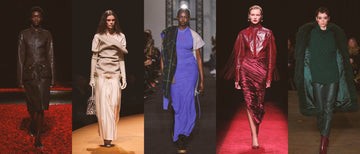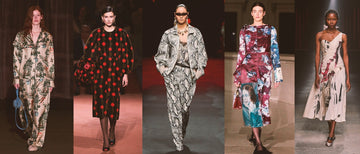History of Houndstooth
A classic houndstooth will be used over and over, get it perfect the first time!

The Houndstooth plaid is one of the more unique looking patterns of the plaid family. It can be easily distinguished by its unique shape of woven pattern, which differentiates it from other types of plaid, which often follow uniform, straight-lined checks. The Houndstooth plaid is widely recognised as the black and white abstract patterned check, which dates all the way back to the 1800’s, where it first appeared in the Lowlands of Scotland, much similar to its fellow plaid, the Tartan, with it’s Scottish Heritage.
The Houndstooth plaid is characterised as being a duo-tone plaid, made up of four bands, two which are dark coloured, and the other two light, in both the warp and weft weave, which are woven in a standard, simple 2:2 twill weave. This creates the unique contrasting check and block shape of the Houndstooth. By experimenting with the size, scale and colours of the weave, many variations can be created.
The Houndstooth check is known to have been first woven in the Scottish Lowlands. This appearance in the 1800’s is considered to be the first ‘contemporary’ version of this plaid, with the very first version of the fabric being found to be from Sweden, from between the times of 360 and 100 BC, and known as ‘Gerum Cloak’. However, there is little information available today on this very early version of the check, with most of its historical story coming from 1800 onwards.
It is believed that the first use of the Houndstooth fabric was as outerwear for shepherds, woven from wool. This is fitting with its early name of the ‘Shepherds Check’, which then transitioned to ‘Dogstooth’, before being known today as Houndstooth. It is also known to be referred to as ‘Puppytooth’, when woven in smaller checks. It is believed that this was its name before ‘Dogstooth’ took over as the size of the check was increased. The name Houndstooth comes from the jagged shape of the check being referenced as being similar to the shape and outline of the tooth of a hound dog.
After originating from use as outer garments for shepherds, the Houndstooth fabric was claimed by Scottish clans around the 1920’s, where it was used for tartan designs. However, unlike many other plaid designs in Scotland, the Houndstooth was never used to represent any clans, leaving it unclaimed by Scottish families.
The reference to the name ‘Houndstooth’ is claimed to not have been used until the mid-1930’s, by when it had become a representation of wealth by the upper-class population. This became of mass significance when the then Prince of Wales, Edward the VII, chose to wear the check as his day-to-day attire. This also created significance for the Houndstooth check as it showcased the plaid to many more people and became a symbol of money and wealth. This new appearance of the check also created a new opportunity for manufacturers by creating a growing demand by the general public for the newfound plaid. Around this time, as the fabric caught on and its awareness spread internationally, it gradually became a classic and staple check for designers around the world. It was adopted by many notable designers, including Christian Dior, Louis Vuitton, and Chanel, as a staple new fabric design. However, instead of weaving the check, many designers would print the pattern onto fabrics for womenswear collections, instead of it being woven. As the popularity of the check grew, many designers began to experiment with it and steer away from the traditional black and white colours, creating bold and colourful new designs.
Since the rise in popularity of the Houndstooth back in the 1930’s, the check has continued to evolve and be adapted in contemporary ways. Today, it is still commonly used in fashion, interiors, and on home furnishings. It is commonly used in men’s suits and women’s dresses, skirts and coats in the smaller form, and throughout interiors it is common to be seen as a larger check. Although versatile and found reoccurring year on year in fashion shows, it is a classic plaid commonly seen in fall/ winter collections.
The Houndstooth plaid is a versatile and timeless plaid that can be incorporated into many contemporary fashion pieces and prints, and used in a variety of colourful, bright, or neutral and dark contrasting colourways.
REFERENCES
https://www.aulitfinelinens.com/blogs/betweenthesheets/a-history-of-houndstooth
https://mullenandmullen.co.uk/blogs/news/everything-you-need-to-know-about-houndstooth
https://hespokestyle.com/houndstooth-fabric-pattern-history/
https://www.sahomeowner.co.za/history-houndstooth/
 |
Katie Kelly |
| Katie Kelly is a recent Textile Design, and Business and Marketing Graduate from Scotland. She loves travelling, exploring new places and doing anything creative. While studying, Katie specialised in printed textiles, and loves creating all types of prints and patterns, especially experimenting with colour and texture! |






1 comment
Great story.
As the eldest veteran son, from a full fledged American family with a Welsh heritage, we claim a deep blue puppytooth as our clan sett.
😂🤷♂️😂